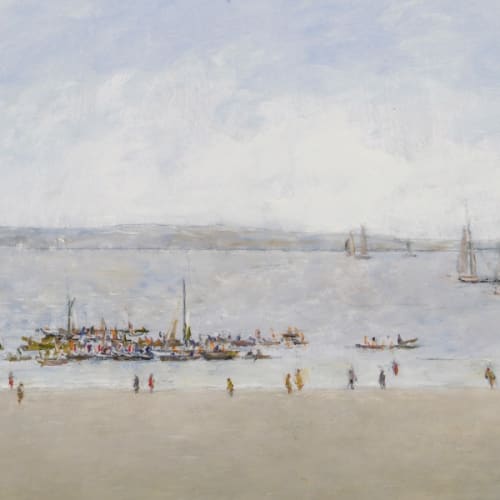Richard Ernst Eurich NEAC OBE RA (14 March 1903 – 6 June 1992) was an English painter who worked as a war artist to the Admiralty in the Second World War and was also known for his panoramic seascapes and narrative paintings. These were often invested with a sense of mystery and wonder which have tended to set him apart from mainstream development of art in the twentieth century.
Read our interview with Richard Eurich's daughters
Early Years
Born in Bradford, he went on to study at Bradford School for Arts and Crafts in 1922 and continued his training at the Slade School of Art under Professor Henry Tonks until 1926.
Whilst still a student, Eurich met Sir Edward Marsh - a great patron of the arts. He took Eurich under his wing and together with Eric Gill was instrumental in arranging Eurich's first one-man show at the Goupil Gallery in 1929. At the opening, Eurich met the artist Christopher Wood who advised him to "paint what you love and damn all fashions that come and go" - advice Eurich took to heart. Marsh also introduced Eurich's work to the Redfern Gallery. A subsequent show there in 1933 was so successful that the Redfern offered him a contract to act as his London dealer. This association lasted for 25 years. Eurich spent the early part of the 1930s living in small fishing ports on the south coast of England and in 1934 he settled in Dibden Purlieu on the edge of the New Forest. The nearby Southampton Water and the Solent became regular subjects of his paintings.
World War Two
In June 1940 Eurich wrote to the War Artists' Advisory Committee, WAAC, suggesting the withdrawal from Dunkirk as a subject, as he had previously painted in the port at Dunkirk. His panoramic painting of the Dunkirk beaches made his name overnight when it was shown at the National Gallery in August 1940. Eurich was then given a commission to paint Admiralty subjects which lasted from 1941 to 1945 during which time he painted, sometimes, epic reconstructions of battle scenes, depictions of survival stories and also simpler paintings of ships and boats. Eurich painted reconstructions of British Commando raids on Vaagso, Bruneval and Dieppe. He also painted scenes representing the D-Day landings, the Battle of Salerno, the wreck of the Tirpitz and air attacks on a convoy. In total during the war, Eurich completed some 34 oil paintings and one drawing for WAAC.
Eurich first had a picture exhibited at the Royal Academy in 1937. In 1942, he was elected an Associate member and became a full Academician in 1953. He became a member of the New English Art Club in 1943 and was an honorary member of the Royal Society of Marine Artists.
Commissions and teaching
Following the war, Eurich accepted a range of commissions. Amongst these was one from Evelyn Waugh to depict the interior of a Dakota aircraft about to crash (The Pleasures of Travel, 1951) which he painted in 1953. Also in 1953, he painted the Queen's Coronation for an illustrated newspaper. Then in 1956 came the Rededication of Rouen Cathedral. From 1958-1965 he did a series for the Shell Shilling Guides of various counties. The Esso Oil Refinery at Fawley in Hampshire was close to where he lived and in 1960 he painted a picture of "The Seven Sisters". In 1968, he painted the large diptych depicting Whitby Harbour and Chatsworth House for the Teaching Hospital in Sheffield. From 1949-1968, Richard taught part-time at Camberwell School of Art under Leonard Daniels. From 1969-1971, he taught part-time at the Royal Academy Schools.
Later life
After WW2, Eurich started a five-year association with Arthur Tooth and Sons. From 1973 he began to exhibit at the Fine Art Society. In 1951 & 1980 there were retrospective exhibitions organised by the Bradford Art Galleries. In 1981, he was awarded the OBE. In 1991 the Imperial War Museum, assisted by the Fine Art Society, put on a retrospective exhibition which, although he was ill, Eurich managed to attend.
Family
In 1934 Eurich married Mavis Pope, a teacher at Southlands Training College in Wimbledon. The couple set up home in the New Forest and they had four children.
- This is an edited version of Richard Eurich's biography on Wikipedia.
- You can view over 100 of his paintings on his profile page at ArtUK.
- A catalogue raisonné of his work is now available on the official Richard Eurich website
- Discover the story behind creating the catalogue raisonné in our interview with Philippa Bambach in which she recounts researching & photographing her late father's work
